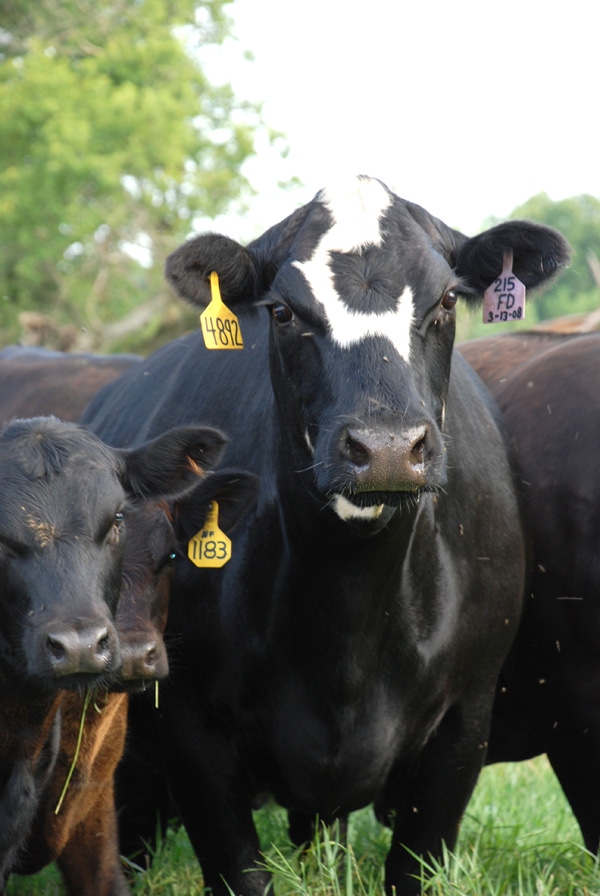A Salmon, ID, rancher details her operation's experience with crossbreeding.
January 20, 2012

My husband and I started crossing Angus and Hereford cattle in the 1960s, breeding a Hereford bull to Angus cows. We felt this cross worked better than the reverse (Angus bull on Hereford cows – the traditional cross), since our Angus cows were good mothers and milked better than the Herefords we had at that time.
The first Hereford bull we selected was ideal to complement the Angus cows; he was long-bodied and very structurally sound, with good bone, muscle and excellent disposition. He was also very fertile, often breeding 50 females in a season in rugged range conditions; we used him until he was 10½ years old. We eventually used three different Hereford bulls (of different bloodlines) on our Angus cows.
We kept a lot of the crossbred females, and they became the foundation for our own composite. They had much better dispositions than their Angus mothers, and had excellent fertility and longevity, raising good calves well into their teens.
We added more breeds to the mix by using crossbred bulls, the first of which were 1/2 Hereford and 1/2 Holstein. These were all sons of an outstanding Holstein cow with good disposition, excellent body structure and good udder. She was the family milk cow, and the epitome of longevity (and strong udder structure); we milked her until she was 21 years old.
The Hereford-Holstein bulls bred to the black baldy cows produced calves that were 1/2 Hereford, 1/4 Angus and 1/4 Holstein. Those three-way cross females were exceptionally athletic, hardy and fertile, with good udders, and the best range cows we’d ever seen. They grazed in mountainous terrain other cattle wouldn’t climb, and thrived in harsh conditions – wintering on native grass until it was snowed under, then fed grass hay through calving and breeding, breeding in 32 days (during April) before going to summer range in May. These cows had no pampering – no supplement, no alfalfa – just the feed produced by the ranch and salt.
By that time (late 1970s), we were no longer turning bulls out on the range. Range breeding in our part of the country always results in a strung-out calving season, and there’s no way to selectively breed – with all cattle running together. We decided to calve earlier so we could breed everything at home.
We’d backed the cows up (from April calving to January) within just a few years, thanks to the exceptional fertility of the crossbred females, able to rebreed quickly without pampering. Then we were able to breed every cow selectively, and have all the cows bred before they went to the range.
These hardy cows made the difference between staying in business or not on a marginal, steep mountain ranch. Straightbred cattle couldn’t make it, because they couldn’t breed back under those conditions, but the crossbred cows managed just fine. After several generations of keeping only the heifers that could breed in 32 days (and almost all of them did), it was a very fertile herd.
We raised most of our own bulls, keeping crossbred bulls from our best cows, using detailed records on bloodlines, cow traits, etc. Utilizing several breeding pastures, we could breed every cow to a bull chosen for her. In this way, related animals could stay in the herd without inbreeding. We could breed the mother, sisters and daughters of a good bull to a different bloodline.
A little Simmental was added to the mix (in the late 1970s and early 1980s), using two halfblood bulls produced by artificial insemination from a couple of our own Hereford-Angus-Holstein heifers. Their calves were only a 1/4 Simmental, which was just right for our mix. In the 1980s and early 1990s, several Angus-Limousin bulls were purchased from a neighbor who bred his Angus cows to good Limousin bulls from Canada. Again, the 1/4 Limousin calves from the halfblood bulls were ideal for our purposes. Our herd was a nice blend of several breeds.
The key to keeping the mix of breeds the way we wanted it was that whenever new blood was added, it was usually in the form of crossbred bulls, not purebred; then, with selective breeding, we focused on the desired traits from each breed. We called this “stirring the mix” and having the best traits come through in the calves. We focused on accentuating the strengths of each breed and minimizing the weaknesses.
Technically our homegrown mix wasn’t a true composite because we didn’t have the numbers and generations to create a uniform blend. But they served our purpose very well, greatly outperforming the straightbred cattle we started with, on all counts.
We occasionally had to use a purebred bull, but by breeding those bulls to selected crossbred cows, we raised bulls that were better than their purebred sire. The crossbred bulls always outperformed the purebred bulls, and could always be depended on to do the job – as well as to produce outstanding calves. On average, the crossbred bulls were more athletic, structurally sound (with no breakdowns, reproductively), more energetic, and always eager to do the job.
After several decades of using a variety of bulls, and stirring the mix, our homegrown hybrid bulls truly spoiled us. They were the most dependable breeders, sired exceptionally good calves, and we didn’t have to buy them. Instead, they generated an extra “cash crop” each summer, when we retired and sold the older ones after the breeding season. We always had plenty of younger ones to take their place.
Heather Smith Thomas is a rancher and freelance writer from Salmon, ID.
You May Also Like
.png?width=300&auto=webp&quality=80&disable=upscale)


